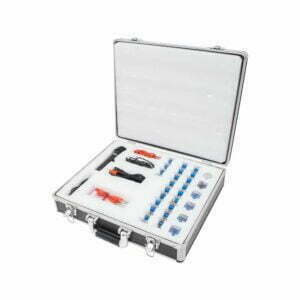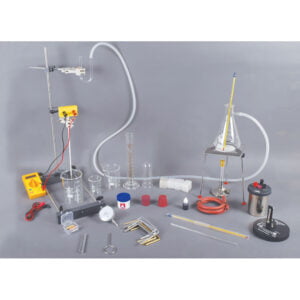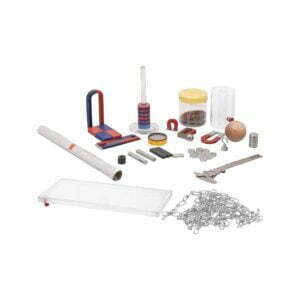-
Electronics
Geiger Muller Counter
Supertek’s Geiger muller counter immediately detects particles emitted by radioactive source, most commonly beta and gamma ray particles. The number of clicks heard over a period of time represents relative rate of decay for the radioactive source being sampled.
Specification:
Range:
- γRay – 20 to 120 mR/h
- βRay – 100 to 1800 mR/h
GM Tube:
- Diameter: Ø10 mm
- Total length: 90 mm
Product Features:
- Digital display.
- Continuous operation of up to 20 hours.
- Tare function to set the initial zero values.
- Portable and ergonomic hand-held design.
- For use in schools and other educational institutions.
- Includes rechargeable battery along with charger.
- Transparent cover to protect GM tube from breakage.
- Instantaneous and cumulative values are displayed simultaneously.
PH96060 -
Experiments
Pin Diode Characteristics Experiment
OBJECTIVES
- To study the response of PIN diode, in the following conditions:
- Photocurrent (Iph) vs Applied voltage at constant irradiance (Φ) under Reverse biased condition of the PIN diode.
- Current (I) vs Voltage (V) under forward bias condition of the PIN diode.
PRINCIPLE
The PN-Junction diodes, though versatile, have a few limitations regarding the amount of current they could handle before breakdown and also have low switching frequency, low power handling capacity, and low quantum efficiency. To overcome all these issues PIN diode was designed. PIN diodes are also extensively used as photodiodes in PIN photodiode configuration and are very important in optical fiber communication.
KEY FEATURES
- Precise Optical Alignment: The optical alignment of the components is attained by the optical bench, the set-up time is faster and experimentation is easy.
- Fine and Easy Light Intensity Adjustment: Light intensity adjustment is done via the use of two polarizers. This helps in easier and fine light intensity adjustments.
- Simple and Easy Connections: The color-coded terminals on the various components aid in the ease of connections thus reducing the setup time.
WHAT YOU NEED
- OB2 Optical Bench Set 0.4m 1
- HA001 Light Source Holder 1
- HA004 Polarizer Holder 1
- HA006 Analyzer Holder 1
- HA021 Photodiode Module Holder 1
- PH64505 Multimeter 1
- PH61022D/2 Power Supply for Light Source 2
Complete Equipment Set with Instruction Manual from catalogue.
PIN1-C -
Experiments
Planck Constant Experiment
OBJECTIVES
To determine Planck’s constant using LED.
PRINCIPLE
KEY FEATURES- Built-In Heater: The heating element is built into the system and is powered by 12V input. The efficient heating mechanism heats the system to the required temperature in a few minutes with a minimum power requirement of 40W.
- Modular Design: The modular design of the setup allows the testing of different colored LED’s.
- Built-In Voltage and Temperature Probe: All the necessary parameters to be measured are available directly on the setup itself.
WHAT YOU NEED
PH94004 Planck Constant Apparatus 1 PH61035D/5 Power Supply 1 PH64505 Multimeter 1 AC026 Syringe, 20ml 1 AC028 Silicone Oil, 50ml 1 Complete Equipment Set with Instruction Manual from catalogue.
PLC1-C -
Experiments
Quinck’s Tube Experiment
Objectives
To measure the magnetic susceptibility of a given paramagnetic sample (FeCl3).
Principle
The Quinck’s method is used to determine magnetic susceptibility of diamagnetic or paramagnetic substances in the form of a liquid or an aqueous solution. When an object is placed in a magnetic field, a magnetic moment is induced in it. Magnetic susceptibility x is the ratio of the magnetization I (magnetic moment per unit volume) to the applied magnetizing field intensity H. The magnetic moment can be measured either by force methods, which involve the measurement of the force exerted on the sample by an inhomogeneous magnetic field or induction
methods where the voltage induced in an electrical circuit is measured by varying magnetic moment.Key Features
- Compact Setup – The apparatus design is compact and yet effective to perform the experiments with ease. The simple connections and stand to hold the teslameter probe, makes it easy to handle.
- Custom Quinck’s Tube – Specially designed quinck’s tube can be attached seamlessly on the setup and dimensions are controlled such that it fits perfectly between the pole pieces.
Equipments Needed for the Experiment
- PH94012 Electromagnet for Quinck’s Tube 1
- AC030 Quinck’s Tube 1
- PH61035D/7 Power Supply for Electromagnet 1
- PH93225G Teslameter, Digital 1
- PH30780 Vernier Microscope 1
QTE1-C -
Experiments
Quarter and Half Wave Plate Experiment
OBJECTIVES
To study the effect of wave plates on polarized light
- Quarter wave plate
- Half wave plate
PRINCIPLE
Waveplates are optical devices that resolve a light wave into two orthogonal linear polarization components by producing a phase shift between them. The transmitted light may have a different type of polarization than the incident beam due to the induced phase difference. Commonly used retarders are quarter-wave plates and half-wave plates. The quarter-wave plate is used to convert a linearly polarized input beam into a circular (or elliptical) polarized beam and vice-versa. Half-wave plate rotates the plane of polarization of linearly polarized light that is input on it by twice the angle between its optical axis and the initial orientation of the linearly polarized light.
KEY FEATURES
- Precise Optical Alignment: The optical alignment of the components is attained by the optical bench, the set-up time is faster and experimentation is easy.
- Digital Lux Meter: This enables the measurement of light intensity at various angles of reflection. The meter reads with a precision of 1 lux.
- Easy and accurate adjustments: The design of the setup helps in the easier rotation of wave plates without blocking the path of light. The least o count of 1 aid in accurate readings
WHAT YOU NEED
OB1 Optical Bench Set 0.8m 1 UP001 Upright 1 HA001 Light Source Holder 1 HA004 Polarizer Holder 1 HA006 Analyzer Holder 1 HA510 Light Sensor Holder 1 DP1 Data Processor 1 PH61022D/2 Power Supply for Light Source 1 HA030 Quarter Wave Plate Holder 1 HA031 Half Wave Plate Holder 1 Complete Equipment Set with Instruction Manual from catalogue.
QWP1-C -
Micropipettes
High Precision Micropipettes (RBO Series) Variable Volume Fully Autoclavable
High precision micropipette series for advance users in the field of Molecular biology, Microbiology, Immunology, Cell Culture, Analytical Chemistry, Biochemistry, Genetics etc. High quality spring mechanism ensures softer plunger movement. Nine volume ranges cover the complete pipetting range from 0.2 µl to 10 ml offering a wide choice to select the most suitable model for any application.
Color Coding: Attractive color coding for easy identification between different volume ranges.
RBO -
Micropipettes
Fully Autoclavable Fixed Volume Micropipettes (RBO Series)
Fixed Volume Pipettes are designed for many different types of routine laboratory work. Using the some state-of-art design and basic features of Variable Volume Pipettes, these fixed volume pipettes are ideal for Clinical Diagnostics, Control Analysis etc.
RBO-F -
-
Science Kits
Electronics Kit 1
Electronics Kit 1 includes materials for over 10 activities on electronics-based topics. The kit comes in a heavy-duty carry-case for ease of storage. A full manual with detailed activities for both the teacher and the student is included.
Experiments include:
- Forward Bias Diode,
- Half-Wave Rectifier,
- Zener Diode,
- Transistor as a Switch,
- Measuring Gain with a PNP Power Transistor,
- Infrared Diode and Phototransistor,
- Light Dependent Resistor,
- Temperature Dependent Resistors,
- Silicon Controlled Rectifier,
- TRIAC,
- Unijunction Transistor.
SKEL01 -
Science Kits
Electronics Kit 2
Electronics Kit 2 is a supplemental kit to Electronics Kit 1. It includes materials for 5 activities on advanced electronics-based topics. The kit comes in a heavy-duty carry-case for ease of storage. A full manual with detailed activities for both the teacher and the student is included.
Experiments topics include:
- Stable multivibrator,
- Full wave rectifier,
- Full wave rectifier with the capacitor,
- Push-pull amplifier,
- Two-stage audio amplifier,
- Two-stage audio amplifier.
SKEL02 -
Science Kits
Electrostatics Kit 1
Electrostatics Kit 1 includes materials for over 10 activities on electrostatic-based topics. The kit comes in a heavy-duty carry-case for ease of storage. A full manual with detailed activities for both the teacher and the student is included.
Experiments topics include:
- Electrostatics with rods and cloth,
- Charge distribution on an object,
- Types of charges,
- Comparing magnetic and electrostatic forces,
- Electroscope,
- Insulator versus conductor,
- Charging by induction and conduction,
- Electrophorus,
- Coulomb’s law,
- Charge inside a conductor,
- Faraday’s ice pail.
SKES01 -
Science Kits
Heat Kit 1
Heat Kit 1 includes materials for over 13 activities on thermodynamics-based topics. The kit comes in a heavy-duty carry-case for ease of storage. A full manual with detailed activities for both the teacher and the student is included.
Experiments include:
- Psychrometry,
- Newton’s law of cooling,
- Specific heat of metals,
- Specific heat of water,
- Expansion of water,
- Heat of fusion,
- Linear expansion of a solid,
- Phase transitions and cooling curves,
- Heat conduction in a rod,
- Convective heat transfer,
- Pulse glass,
- Expansion of a gas,
- Expansion of a liquid,
- Thermocouple,
- Thermostat.
SKHE01 -
Science Kits
Mechanics Kit 1
Mechanics Kit 1 includes components for 18 activities on mechanics-based topics. The kit comes in a heavy-duty carry-case for ease of storage. A full manual with detailed activities for both the teacher and the student is included.
Experiments include:
- Pendulum- simple harmonic motion,
- The constant motion of a cart,
- Constant acceleration of a cart,
- Free fall,
- Inertia,
- Newton’s second law,
- Newton’s third law,
- Relationship between weight and mass,
- Pulleys with a spring,
- Vertical force table and vector addition,
- Pulley mechanical advantage,
- Lever,
- Atwood machine,
- The mechanical advantage of multiple pulley system,
- Incline plane,
- Friction,
- Hooke’s law with springs,
- Harmonic motion of a spring.
SKME01 -
Science Kits
Mechanics Kit 2
Mechanics Kit 2 includes materials for over 13 activities on fluid mechanics. The kit comes in a heavy-duty carry-case for ease of storage. A full manual with detailed activities for both the teacher and the student is included along with scientific background on each topic.
Experiments include:
- Water velocity from a spout,
- Mariotte’s bottle,
- Force pump,
- Boyle’s law with a syringe,
- Pascal’s ball,
- Communicating vessels,
- The density of an unknown liquid (U tube),
- Open tube manometer,
- Hare’s apparatus,
- Cartesian diver,
- Bernoulli’s principle,
- Viscosity (Ostwald viscometer),
- Capillary tubes.
SKME02 -
Science Kits
Magnetics Kit 1
Magnetics Kit 1 includes materials for 7 activities on magnetism-based topics. The kit comes in a heavy-duty carry-case for ease of storage. Simple to set up with all components easily accessible. A full manual with detailed activities for both the teacher and the student is included along with scientific background on each topic. Activities are designed to guide students to discover concepts but are styled so the instructor knows what equipment is needed for each activity.
Experiments include:
- Magnetic and non-magnetic objects,
- North and south poles,
- Earth’s magnetic field,
- Observing magnetic field lines,
- Interacting forces,
- Strength of magnets using ferromagnetic chains,
- Eddy currents.
SKMG01 -
Science Kits
Magnetics Kit 2
Magnetics Kit 2 is a supplemental kit to Magnetics Kit 1. It includes materials for 4 activities on advanced magnetism-based topics. The kit comes in a heavy-duty carry-case for ease of storage. A full manual with detailed activities for both the teacher and the student is included.
Experiments include:
- Diamagnetic, Paramagnetic, and Ferromagnetic Substances,
- Predicting Magnetic Field Lines,
- Current Induced Magnetic Fields,
- Magnetic Field Induced Current.
SKMG02 -
Experiments
Size of Particle Experiment
OBJECTIVES
- To measure the width/thickness of the given samples by analyzing the diffraction pattern.
PRINCIPLE
The characteristics of light such as interference and diffraction can be understood when light is studied as a wave phenomenon. Interaction of waves with matter results in either transmission, reflection, absorption, or diffraction of the wave. When the size of the matter is comparable to the wavelength of the wave that it interacts with, a phenomenon called diffraction occurs. Diffraction of light due to particles is a function of the size of the particle and the wavelength of the light incident. It is possible to measure the size of a particle by studying the diffraction patterns created by it.
KEY FEATURES
- Easy Adjustable Laser: The multiple degrees of freedom on the laser mount helps in the effortless movement of the laser source. This helps in aligning the laser source with the sample quite easily.
- Laser Range Finder: The addition of a laser range finder allows the user to use any standard wall as a screen, increasing the distance between the screen and the sample. Thus, the diffraction pattern can be seen distinctly and thus increasing the accuracy of the readings.
- Multiple Samples can be Tested and Verified: The modular setup helps in measuring the diameters of different samples and other everyday objects as well.
WHAT YOU NEED
- OB1 Optical Bench Set 0.8m 1
- HA003 Laser Source Holder 1
- HA008 Grating Holder 1
- HA024 Screen Holder 1
- AC010 Laser Distance Meter 1
- AC018 Diffraction Grating 1
- AC012 Frame With Thread Type 1 1
- AC014 Frame With Thread Type 2 1
- AC016 Frame With Thread Type 3 1
Complete Equipment Set with Instruction Manual from catalogue.
SOP1-C -
Experiments
Single Slit Experiment
OBJECTIVES
- To find the wavelength of a given laser using the slit of known width.
- To find the slit width knowing the wavelength of light used.
- Proving the concept of the Heisenberg uncertainty principle.
PRINCIPLE
Diffraction is a phenomenon of bending of waves when it encounters obstacles or narrow opening. A basic setup to observe diffraction consists of a laser, a slit, screen placed at a distance. The wavefronts are partially obstructed by the slit. The intensity distribution of the diffraction pattern consists of a series of light and dark fringes with the intensity distribution symmetric along the central axis. The primary peak is called the central maxima. The corresponding peaks are called secondary, and tertiary maxima. This is studied using the single-slit experiment.
KEY FEATURES
- Precise Optical Alignment: The optical alignment of the components is attained by the optical bench, the set-up time is faster and experimentation is easy.
- Digital Lux Meter with Transverse Saddle: The digital Lux meter enables the measurement of light intensity. The transverse saddle helps in the fine movement of the Lux meter perpendicular to the direction of light.
WHAT YOU NEED
OB1 Optical Bench Set 0.8m 1 HA003 Laser Source Holder 1 HA012 Adjustable Collimating Slit Holder 1 HA512 Travelling Light Sensor Holder 1 DP1 Data Processor 1 PH61022D/2 Power Supply for Light Source 1 Complete Equipment Set with Instruction Manual from catalogue.
SSE1-C


















